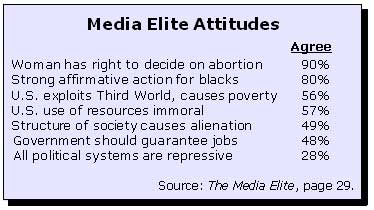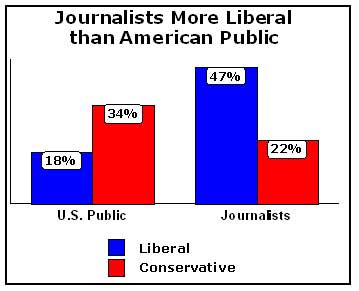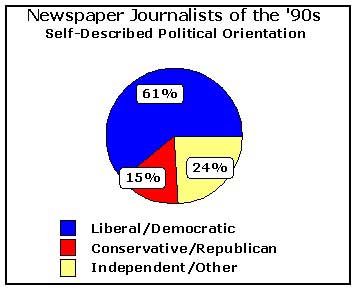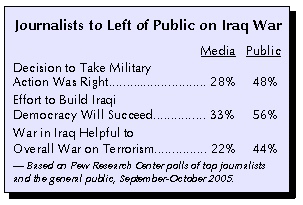|
Journalists’
Political Views
The Media Elite •
The
American Journalist •
Los Angeles Times Survey •
Survey of Business
Reporters •
Journalists — Who Are They, Really? •
Newspaper
Journalists of the '90s •
The Media Elite Revisited •
The People and
the Press: Whose Views Shape the News? •
How Journalists See
Journalists in 2004 •
The News Media and the
War, 2005
The Media Elite
In 1981, S. Robert
Lichter, then with George Washington University, and Stanley Rothman
of Smith College, released a groundbreaking survey of 240
journalists at the most influential national media outlets —
including the New York Times, Washington Post, Wall Street Journal,
Time, Newsweek, U.S. News & World Report, ABC, CBS, NBC and PBS — on
their political attitudes and voting patterns. Results of this study
of the “media elite” were included in the October/November 1981
issue of Public Opinion, published by the American Enterprise
Institute, in the article “Media and Business Elites.” The data
demonstrated that journalists and broadcasters hold liberal
positions on a wide range of social and political issues. This
study, which was more elaborately presented in Lichter and Rothman’s
subsequent book,
The Media Elite, became the most widely quoted
media study of the 1980s and remains a landmark today.
KEY FINDINGS:
- Nearly half of the
journalists surveyed agreed that “the very structure of our
society causes people to feel alienated,” while the authors found
“five out of six believe our legal system mainly favors the
wealthy.”
- 30 percent
disagreed that “private enterprise is fair to workers;” 28 percent
agreed that “all political systems are repressive.”
- 54 percent did not
regard adultery as wrong, compared to only 15 percent who regarded
it as wrong.
- “Ninety percent
agree that a woman has the right to decide for herself whether to
have an abortion; 79 percent agree strongly with this pro-choice
position.”
- Majorities of
journalists agreed with the statements: “U.S. exploits Third
World, causes poverty” (56%) and “U.S. use of resources immoral”
(57%). Three-fourths disagreed that the “West had helped Third
World.”

The American
Journalist
In late 1982 and early
1983, Indiana University journalism professors David H. Weaver and
G. Cleveland Wilhoit surveyed more than 1,000 journalists, and
reported the results in their 1986 book,
The American Journalist.
Their poll included more than just top reporters, and, overall, they
detected only a modest skew towards the liberal side of the spectrum
— 22 percent of those interviewed called themselves liberal,
compared with 19 percent who said they were conservative. But among
136 executives and staffers at “prominent news organizations” — the
three weekly newsmagazines, the AP and UPI wire services and the
Boston Globe — the liberal tilt was much more pronounced, with
liberals outnumbering conservatives by a more than two-to-one margin
(32 to 12 percent). Only six percent of this group identified
themselves as Republican, compared with seven times as many (43
percent) who said they were Democrats.
KEY FINDINGS:
- Journalists were
instructed: “The media are often classified politically in terms
of left, right and center. On a scale from zero (meaning extreme
left) to one hundred (meaning extreme right)....where on this
scale would you place yourself?”
- Most of the
journalists surveyed (57.5%) chose numbers that placed themselves
in the middle of the spectrum, with 22.1 percent ranking
themselves as more liberal, and 17.9 percent saying they were more
conservative, and 2.5 percent not responding.
- “When the political
leanings of U.S. journalists are analyzed separately for executive
(those who supervise editorial employees) and staffers of
prominent and nonprominent news organizations, we find more
journalists (both executives and staffers) from prominent
organizations claiming to be left-of-center.”
- Among the
prominent, or elite, media, 32.3 percent rated themselves as more
liberal, compared to 11.8 percent who said they were more
conservative. Eight percent rated themselves as solidly “left,”
but none of the media elite would place themselves squarely on the
“right.”
- Nearly four in ten
of all journalists surveyed (38.5%) described themselves as
Democrats, compared to just 18.8 percent who said they were
Republicans. Among the journalists working at prominent news
organizations, just 6 percent would admit to being Republicans,
compared to 43 percent who said they were Democrats.
Los Angeles Times
Survey
In 1985, the Los
Angeles Times conducted one of the most extensive surveys of
journalists in history. Using the same questionnaire they had used
to poll the public, the Times polled 2,700 journalists at 621
newspapers across the country. The survey asked 16 questions
involving foreign affairs, social and economic issues. On 15 of 16
questions, the journalists gave answers to the left of those given
by the public.
KEY FINDINGS:
- Self-identified
liberals outnumbered conservatives in the newsroom by more than
three-to-one, 55 to 17 percent. This compares to only one-fourth
of the public (23 percent) that identified themselves as liberal.
- 84 percent of
reporters and editors supported a so-called "nuclear freeze" to
ban all future nuclear missile deployment; 80 percent were against
increased defense spending; and 76 percent opposed aid to the
Nicaraguan Contras.
- 82 percent of
reporters and editors favored allowing women to have abortions; 81
percent backed affirmative action; and 78 percent wanted stricter
gun control.
- Two-thirds (67%) of
journalists opposed prayer in public schools; three-fourths of the
general public (74%) supported prayer in public schools.
Survey of Business
Reporters
A 1988 poll by a New
York-based newsletter, Journalist and Financial Reporting, surveyed
151 business reporters from over 30 publications ranging from the
Los Angeles Times, Washington Post, USA Today, New York Times and
Chicago Tribune to Money, Fortune and Business Week. The survey
found that newspaper and magazine business reporters are just as
liberal as their colleagues covering politics.

KEY FINDINGS:
- 54 percent
identified themselves as Democrats, just 9 percent as Republicans.
- 76 percent reported
they opposed school prayer and 75 percent were against aid to the
Contras, rebels fighting the Communist-backed Nicaraguan
government. An overwhelming 86 percent favored abortion.
- More than half, 52
percent, evaluated President Reagan’s performance in office as
“poor” or “below average.” Only 17 percent gave him an “excellent”
or “good,” while 19 percent considered him “average.”
- Asked who they
wished to see become President, 27 percent named liberal New York
Governor Mario Cuomo (D), trailed by 20 percent for Senator Bill
Bradley (D-NJ) and nine percent for Senator Paul Simon (D-Ill).
Senator Bob Dole was the most “popular” Republican, garnering a
piddling eight percent.
- Rev. Pat Robertson,
then a GOP candidate, topped the list — at 44 percent — of those
the reporters would “least like to see as President,” followed by
19 percent who named the eventual winner that year, George H. W.
Bush.
Journalists — Who
Are They, Really?
In 1992, Professors
Weaver and Wilhoit conducted another national survey of journalists,
and noticed the group had moved farther to the left. Writing in the
Fall 1992 Media Studies Journal, they discovered that 47 percent of
journalists now said they were “liberal,” while only 22 percent
labeled themselves as “conservative.”
KEY FINDINGS:
- 44 percent of
journalists identified themselves as Democrats, an increase from
the early 1980s, while 16 percent tagged themselves as Republican,
a decline from the earlier study.
- “Compared to the
overall U.S. population, journalists are 3 percent to 10 percent
more likely to say they are Democrats, depending on which national
survey you use as a yardstick, and 10 to 17 points less likely to
say they are Republicans.”

- Nearly half of the
journalists surveyed (47 percent) called themselves “liberal,”
compared to 22 percent who described themselves as “conservative.”
Gallup polls taken at the same time found just 18 percent of the
public considered themselves liberal, while 34 percent of the
public said they were conservative.
- The study authors
found “minorities are much more likely to call themselves
Democrats than are white journalists, especially blacks (70
percent), Asians (63 percent) and Hispanics (59 percent).”
- Women journalists
(58 percent) are much more likely than men (38 percent) to prefer
the Democratic Party.
- More than half of
journalists (51%) said abortion should be “legal under any
circumstances,” compared to just 4 percent who thought abortion
should be “illegal in all circumstances.” Among the general
public, 33 percent wanted abortion “legal under any
circumstances,” and 14 percent thought it should always be
illegal.
Newspaper
Journalists of the ’90s
In 1996, as a
follow-up to a 1988 survey, the American Society of Newspaper
Editors (ASNE) surveyed 1,037 reporters at 61 newspapers of all
sizes across the nation, and found that newsrooms were more
ideologically unrepresentative than they had been in the late 1980s.
While the percentage of journalists calling themselves “Democrat or
liberal” essentially held steady (going from 62 to 61 percent of
those surveyed), the percentage saying they were “Republican or
conservative” dropped from 22 percent to just 15 percent of
journalists. The
ASNE report, The Newspaper Journalists of the ’90s,
also revealed that bigger — presumably more influential — newspapers
had the most liberal staffs.
KEY FINDINGS:
- According to ASNE:
“In 1996 only 15 percent of the newsroom labeled itself
conservative/Republican or leaning in that direction, down from 22
percent in 1988. The greatest gain is in the ‘independent’ column,
which rose from 17 percent to 24 percent. Liberal/Democrats and
those leaning that way slipped only from 62 to 61 percent.”

- “Political
orientation does not vary across job descriptions, except that
editorial writers are more likely to be independent or
conservative than staffers in the newsroom.”
- “On papers of at
least 50,000 circulation, 65 percent of the staffs are
liberal/Democrat or leaning that way, and 12 percent are
conservative/Republican or leaning that way.”
- Women in the
newsroom were more likely than men to identify as
liberal/Democratic. Only 11 percent identified themselves as
conservative or leaned that way.
- Minority
journalists are even more liberal/Democrat than other reporters,
with a mere three percent of blacks and eight percent of Asians
and Hispanics putting themselves on the right.
The Media Elite
Revisited
In 1995, Stanley
Rothman and Amy Black polled the news media elite — “reporters and
editors at major national newspapers, news magazines and wire
services” as part of a larger examination of nine elite groups in
the U.S. The results were published in the Spring 2001 issue of
The
Public Interest. They found the media elite held strongly liberal
views on abortion, homosexuality, and a range of economic issues.
“Despite the discrediting of centrally planned economies produced by
the collapse of the Soviet Union and other Communist regimes,
attitudes about government control of the economy have not changed
very much since the 1980s,” the authors marveled.
KEY FINDINGS:
- Nearly all of the
media elite (97 percent) agreed that “it is a woman’s right to
decide whether or not to have an abortion,” and five out of six
(84 percent) agreed strongly.
- Three out of four
journalists (73 percent) agreed that “homosexuality is as
acceptable a lifestyle as heterosexuality,” and 40 percent agreed
strongly.
- Seven out of ten
journalists (71 percent) agreed that “government should work to
ensure that everyone has a job,” and 30 percent said they strongly
agreed with that statement.
- Three-fourths (75
percent) agreed that “government should work to reduce the income
gap between the rich and the poor,” and more than a third (34
percent) strongly agreed.
- Relatively few
journalists (39 percent) agreed that “less government regulation
of business would be good for the economy,” and just five percent
strongly agreed with this sentiment.
The People and the
Press: Whose Views Shape the News?
In the
July/August
2001 edition of the Roper Center’s Public Perspective, Washington
Post national political correspondent Thomas Edsall summarized the
findings of a Kaiser Family Foundation poll of 301 “media
professionals,” 300 “policymakers” and the 1,206 members of the
public. The media professionals included “reporters and editors from
top newspapers, TV and radio networks, news services and news
magazines.” The results showed that “only a tiny fraction of the
media identifies itself as either Republican (4%), or conservative
(6%),” placing reporters far to the left of media consumers.
KEY FINDINGS:
- Four times as many
“media professionals” told the pollsters they considered
themselves “liberal” (25%) than called themselves “conservative”
(6%). Among the general public, self-identified conservatives
outnumbered liberals, 38 percent to 21 percent.

- More than six times
as many media professionals called themselves Democrats (27%),
than said they were Republicans (just 4%). Among the general
public, Democrats slightly outnumbered Republicans, 34 percent to
28 percent.
- Policymakers were
also found to be less liberal than journalists. According to
Edsall, “These areas of divergence between the public and the
press lend themselves to conflict, both with the consumers and the
makers of news, and threaten to diminish the legitimacy of
American journalism.”
- Edsall: “Whether or
not members of the media agree with conservative voters on any
given set of questions is not at issue. The problem is the
invisibility of these men and women to the national media, and,
most especially, the inability of the press to represent their
views in public discourse.”
How Journalists See
Journalists in 2004
In May 2004, the
Pew
Research Center for The People and The Press (in association with
the Project for Excellence in Journalism and the Committee of
Concerned Journalists) surveyed 547 journalists and media
executives, including 247 at national-level media outlets. The poll
was similar to ones conducted by the same group (previously known as
the Times Mirror Center for the People and the Press) in 1995 and
1999. The actual polling was done by the Princeton Survey Research
Associates.
KEY FINDINGS:
- Five times more
national journalists identify themselves as “liberal” (34 percent)
than “conservative” (just 7 percent). In contrast, a survey of the
public taken in May 2004 found 20 percent saying they were
liberal, and 33 percent saying they were conservative.
- The percentage of
national reporters saying they are liberal has increased, from 22
percent in 1995 to 34 percent in 2004. The percentage of
self-identified conservatives remains low, rising from a meager 4
percent in 1995 to a still-paltry 7 percent in 2004.

- Liberals also
outnumber conservatives in local newsrooms. Pew found that 23
percent of the local journalists they questioned say they are
liberals, while about half as many (12 percent) call themselves
conservative.
- Most national
journalists (55 percent) say the media are “not critical enough”
of President Bush, compared with only eight percent who believe
the press has been “too critical.” In 1995, the poll found just
two percent thought journalists had given “too much” coverage to
then-President Clinton’s accomplishments, compared to 48 percent
who complained of “too little” coverage of Clinton’s achievements.
- Reporters struggled
to name a liberal news organization. According to Pew, “The New
York Times was most often mentioned as the national daily news
organization that takes a decidedly liberal point of view, but
only by 20% of the national sample.” Only two percent of reporters
suggested CNN, ABC, CBS, or NPR were liberal; just one percent
named NBC.
- Journalists did see
ideology at one outlet: “The single news outlet that strikes most
journalists as taking a particular ideological stance — either
liberal or conservative — is Fox News Channel,” Pew reported. More
than two-thirds of national journalists (69 percent) tagged FNC as
a conservative news organization, followed by The Washington Times
(9 percent) and The Wall Street Journal (8 percent).
The
News Media and the War, 2005
As part of a larger study of how the views of “opinion leaders”
compare with those of the general public, the
Pew Research Center for The People & The Press, in
collaboration with the Council on Foreign relations, surveyed 72 top
journalists in September and October 2005. The study, which was
released on November 17, 2005, found that, compared to everyday
citizens, journalists were more likely to have opposed the decision
to go to war in Iraq, were more pessimistic about the chances of
success in Iraq, and were far less likely to see immigration reform
as a national priority. Reporters were also more disapproving of
President Bush’s job performance.
KEY FINDINGS:
- The public was
nearly evenly split on whether the U.S. should have invaded Iraq
in 2003, with 48 percent agreeing with the decision and 45 percent
disagreeing. But among journalists, 71 percent said they
considered it a bad decision, compared to just 28 percent that
thought it was the right move.

- Similarly, while
the public is evenly split on whether the war in Iraq will help or
hurt the U.S. in the overall war on terror (44% to 44%), three
times as many journalists say the war in Iraq has been harmful as
think it was helpful (68% to 22%).
- While 56 percent of
the public said “efforts to establish a stable democracy” in Iraq
will succeed, 63 percent of the news media elite think it will
fail.
- Nearly half of the
public (46%) believe torture of terrorist suspects can be “often”
or “sometimes” justified, while 78 percent of the news media elite
contend it is “rarely” or “never” justified.
- Just 17 percent of
journalists said they thought “reducing illegal immigration” was a
“top priority,” compared to 51 percent of the public who rate it
as a “top priority.”
- Just 21 percent of
the media approved of President Bush’s job performance in the fall
of 2005, compared to 40 percent of the public.
Media Bias Basics Home
• How the Media Vote
• Journalists' Political Views
• How the Public Views the Media •
Admissions of Liberal Bias •
Denials of Liberal Bias |